[youtube]ZViZUoJwH-w[/youtube]
Not really a religious piece but makes even a good atheist like me tear up. The Protecting Veil is Tavener’s masterpiece but as short pieces go, this one is special. Who has recommendations for other Orthodox Easter listening?
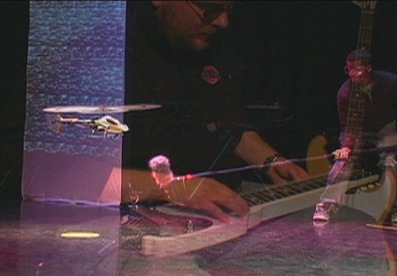
Already mentioned at Bruce Hodges’ Monotonous Forest, and soon should be buzzing all over the new-music web, but this is so absolutely inspired and well-executed that I just have to help spread it around even more: Virgil Moorefield (who was one of my click picks here not so long ago) recently directed the Digital Music Ensemble at the University of Michigan in a miniature version of Karlheinz Stockhausen’s already-audacious Helikopter-Streichquartett. To me this version is every bit as audacious as the original, subversive and absolutely respectful at the same moment… And both visually and aurally stunning, to boot. There are two Quicktime files at the page linked above; the “lo-fi” seems to be just audio, but the “hi-fi” has the full video presentation as well, and is well worth the download.
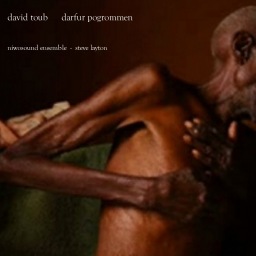 Just when you thought we’ve been musically laying low… There’s a brand-new online-only CD release by fellow S21 regular and composer David Toub, realized by yours truly (Steve Layton, for those of you who don’t read the bottom post tag). It just became available on iTunes (US, also now or very soon in UK/Europe, Australia and Japan) on my little NiwoSound label; expect its appearance on eMusic as well very soon. The CD is in the “electronic” genre at both places, but purely as a matter of expediting the release; if it’s not classical I don’t know what is!
Just when you thought we’ve been musically laying low… There’s a brand-new online-only CD release by fellow S21 regular and composer David Toub, realized by yours truly (Steve Layton, for those of you who don’t read the bottom post tag). It just became available on iTunes (US, also now or very soon in UK/Europe, Australia and Japan) on my little NiwoSound label; expect its appearance on eMusic as well very soon. The CD is in the “electronic” genre at both places, but purely as a matter of expediting the release; if it’s not classical I don’t know what is!
David’s darfur pogrommen, composed only a few months ago, is another expansive minimalist essay; its single continuous movement clocks in at 47 minutes. There’s no real attempt at programmatic writing; rather — like many of David’s other pieces — the title is a marker of a moment, that can call up whatever associations the listener might have in relation to it.
The piece is for open instrumentation. David’s own first recorded version used synthy string sounds, but I decided to give it a kind of “old school” treatment: a Reich-Glass hybrid with a vibraphone and electric organ taking the two primary parts, and electric piano and two more organs adding secondary voices. It trades a little lushness, but finds a bright, hard and uncompromising edge.
The biggest influence is still “classic” 60s-70s Glass, but David has his own way with how figures intuitively expand and contract, the harmonies involved, and his preference for alternating and pulsing notes. But later in the piece there’s a spot that to my ears definitely pays tribute to Morton Feldman as well. Surprising and beautiful!
Though there are many clearly defined sections in the piece, like so much of David’s work there’s just no way to get the whole flow with separate tracks. So if you want it, it’s all or nothing. (You can preview 30 seconds of the beginning on iTunes, but it’s a laughably hopeless indicator of what unfolds…)
Anyone wishing to burn the download to disc can also download and print this PDF file, which gives you the entire cover art and inner notes. More musically, you can freely download the PDF of the entire score from David himself.
Oh yeah: play it LOUD.
“Deze naam zegt jullie allicht niks, Marco Antonio woont nu nog in Gent, maar verhuist binnenkort naar Deinze. Als solist voor kamer- en orkestmuziek heeft Marco Mazzini internationaal opgetreden in volgende toonaangevende plaatsen : Carnegie Hall (New York), Tama Center (Tokyo), Paleis voor Schone Kunsten (Brussel), Bijloke concertzaal (België) en in het Conservatorium van Parijs.”
Terrific article about our amigo Marco Antonio Mazzini in Deinzeonline. Alas, it appears to be in a foreign language but the pictures are nice and the video is splendid:
[youtube]y33fTZJyVlo[/youtube]
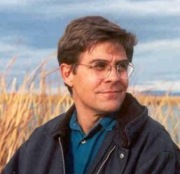 Steve Peters quietly came to Seattle in 2004, after running the non-profit performance organization Nonsequitur out of Albuquerque for 15 years. After a stint at Jackstraw he was finally ready to get back to what he does best (besides making his own wonderful music/sound-art): creating an inviting and flexible space and then filling it up with vital performances. Very soon after its inaugaration this year, the Chapel became probably the premiere initmate space in Seattle for catching new music.
Steve Peters quietly came to Seattle in 2004, after running the non-profit performance organization Nonsequitur out of Albuquerque for 15 years. After a stint at Jackstraw he was finally ready to get back to what he does best (besides making his own wonderful music/sound-art): creating an inviting and flexible space and then filling it up with vital performances. Very soon after its inaugaration this year, the Chapel became probably the premiere initmate space in Seattle for catching new music.
An actual chapel in the beautiful, old Good Shepherd Center (a former home for young girls), tucked into a great park in Seattle’s Wallingford neighborhood, the Chapel accomodates performances from across the musical spectrum, with nary a miss among the bunch. A glance back at an amazing first year:
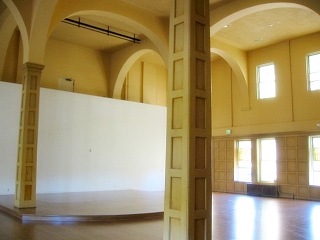 Animist Orchestra // Jessica Catron, cello & Johnny Chang, violin: The Microscores Project // Visual/Sound/Digital Poetry (Subtext Reading Series) // Death Posture butoh // Colin Andrew Sheffield & James Eck Rippie, Phil Hendricks, and Rebreather, electronics // Vanessa Skantze, spoken word/theater performance // Tom Baker Quartet + Sunship // Paul Hoskin, contrabass clarinet // Seattle Composers Salon // Eric Barber, sax & Tom Varner, horn // Duo Juum // Dean Moore, gongs & Bill Horist, guitar // DX ARTS group show // Doug Haire, field recordings // However, poetry + music // Byron Au Yong, voice, piano, percussion & Christopher Blaisdel, shakuhachi // Jeffrey Allport, guitar & Tim Olive, percussion + Cristin Miller, voice & Jason Anderson, electronics // Milind Raikar, Indian violin & tabla + Hell’s Bellows, accordion quartet // Dennis Rea & Stuart Dempster // Lisa Moore, piano // Francisco Lopez & Matt Shoemaker // Piano Christening: Gust Burns, Dawn Clement, Duo Juum, Wayne Horvitz, Julie Ives, Johanna Kunin, Victor Noriega, Amy Rubin, Cristina Valdes // Marathon: 40 artists in 10 hours (Nonsequitur, Jack Straw, Clear Cut Press, Subtext, Phonographers Union, DoubleSharp, WA Composers Forum, Seattle Composers Salon) // Chris Chandler, Paul Benoit, Ela Lamblin, Vishal & Ushwal Nagar // Gust Burns + Julie Ives, piano // Moraine + Snapbite // Gretta Harley, choral/spoken word performance // Duran/Schloss/Mitri Trio + Paul Rucker Quinte // Jim Haynes, sound art + Eric Lanzillotta, analog synth // Gregory Reynolds, sax & Gust Burns, piano // No West Festival of Improvised Music & Dance // Matthew Postle & Derek Terran + Michael Owcharuk Trio // Bling! + Figeater // Yann Novak & Son of Rose // Reptet + Ziggurat Ensemble // Dean Moore & Sha’ari Garfinkel, gongs // Satoko Fujii, piano & Natsuki Tamura, trumpet // Gamelan Pacifica // Diego Piñon butoh // Seattle Latin American Music Festival // Flute Force, flute quartet // Greg Sinibaldi // EQlateral Ensemble // Keith Rowe & friends, improvised guitar etc. // Andrea Parkins, accordion & electronics + Lesli Dalaba, trumpet & Rob Angus, electronics // Gino Robair, improv opera // Trevor Watts & Jamie Harris & Reuben Radding & Jane Rigler // Wally Shoup Quartet & Gust Burns Trio (Earshot) // Tom Baker Quartet // Metal Men, electronics, noise // Malcolm Goldstein, violin // Alexei Pliousnine, guitar // Iva Bittova, violin & voice // October Trio // Margaret Brink, piano + Tom Baker Quartet // Seattle Harmonic Voices // Tiffany Lin & Motoko Honda, piano // Tim Root // Philip Arnautoff, harmonic canon + Christopher Roberts, guqin // Shulamit Kleinerman & friends, medieval violins // Alison Knowles // John Butcher, sax, Torsten Mueller, bass, Dylan van der Schyff, drums // Katsura Yamauchi, sax and Arrington DeDionyso, bass clarinet // Impressions of Romania, chamber music // Paul Rucker Quintet // Sean Osborn, clarinet & Greg Sinibaldi, sax & electronics // Sunship // Wally Shoup Trio // Jhababa & Eric Lanzillotta
Animist Orchestra // Jessica Catron, cello & Johnny Chang, violin: The Microscores Project // Visual/Sound/Digital Poetry (Subtext Reading Series) // Death Posture butoh // Colin Andrew Sheffield & James Eck Rippie, Phil Hendricks, and Rebreather, electronics // Vanessa Skantze, spoken word/theater performance // Tom Baker Quartet + Sunship // Paul Hoskin, contrabass clarinet // Seattle Composers Salon // Eric Barber, sax & Tom Varner, horn // Duo Juum // Dean Moore, gongs & Bill Horist, guitar // DX ARTS group show // Doug Haire, field recordings // However, poetry + music // Byron Au Yong, voice, piano, percussion & Christopher Blaisdel, shakuhachi // Jeffrey Allport, guitar & Tim Olive, percussion + Cristin Miller, voice & Jason Anderson, electronics // Milind Raikar, Indian violin & tabla + Hell’s Bellows, accordion quartet // Dennis Rea & Stuart Dempster // Lisa Moore, piano // Francisco Lopez & Matt Shoemaker // Piano Christening: Gust Burns, Dawn Clement, Duo Juum, Wayne Horvitz, Julie Ives, Johanna Kunin, Victor Noriega, Amy Rubin, Cristina Valdes // Marathon: 40 artists in 10 hours (Nonsequitur, Jack Straw, Clear Cut Press, Subtext, Phonographers Union, DoubleSharp, WA Composers Forum, Seattle Composers Salon) // Chris Chandler, Paul Benoit, Ela Lamblin, Vishal & Ushwal Nagar // Gust Burns + Julie Ives, piano // Moraine + Snapbite // Gretta Harley, choral/spoken word performance // Duran/Schloss/Mitri Trio + Paul Rucker Quinte // Jim Haynes, sound art + Eric Lanzillotta, analog synth // Gregory Reynolds, sax & Gust Burns, piano // No West Festival of Improvised Music & Dance // Matthew Postle & Derek Terran + Michael Owcharuk Trio // Bling! + Figeater // Yann Novak & Son of Rose // Reptet + Ziggurat Ensemble // Dean Moore & Sha’ari Garfinkel, gongs // Satoko Fujii, piano & Natsuki Tamura, trumpet // Gamelan Pacifica // Diego Piñon butoh // Seattle Latin American Music Festival // Flute Force, flute quartet // Greg Sinibaldi // EQlateral Ensemble // Keith Rowe & friends, improvised guitar etc. // Andrea Parkins, accordion & electronics + Lesli Dalaba, trumpet & Rob Angus, electronics // Gino Robair, improv opera // Trevor Watts & Jamie Harris & Reuben Radding & Jane Rigler // Wally Shoup Quartet & Gust Burns Trio (Earshot) // Tom Baker Quartet // Metal Men, electronics, noise // Malcolm Goldstein, violin // Alexei Pliousnine, guitar // Iva Bittova, violin & voice // October Trio // Margaret Brink, piano + Tom Baker Quartet // Seattle Harmonic Voices // Tiffany Lin & Motoko Honda, piano // Tim Root // Philip Arnautoff, harmonic canon + Christopher Roberts, guqin // Shulamit Kleinerman & friends, medieval violins // Alison Knowles // John Butcher, sax, Torsten Mueller, bass, Dylan van der Schyff, drums // Katsura Yamauchi, sax and Arrington DeDionyso, bass clarinet // Impressions of Romania, chamber music // Paul Rucker Quintet // Sean Osborn, clarinet & Greg Sinibaldi, sax & electronics // Sunship // Wally Shoup Trio // Jhababa & Eric Lanzillotta
Whew! The Seattle scene has always been more-or-less alive-and-well, through places like the plucky Gallery 1412, but the Chapel provides a much-needed venue for new and experimental music that takes it out of the back alley and gives it a place where people can respect the space as much as they already do the music and artists. Even if you’re not a Seattlite, keep an eye on their blog for even more wonders this year (or sign up for the mailing list). Major Kudos to Steve P., and wishes for a wonderfully full year to come.
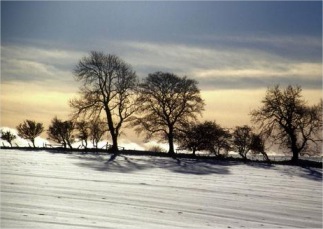 Renewable Music‘s long-time American-in-Deutschland, Daniel J. Wolf, had the idea of inviting composers to contribute to an album for piano, simply centered around this moment and season. No publishers, no glitzy “call for works”, just a friendly invitation for any interested. The result is the A Winter Album, twelve piano pieces of quite diverse hues, for each and everyone of us to freely peruse in our gray and inclement hours. The composers may not be known to you, but all the better; they’re a stellar bunch in my book: Dennis Báthory-Kitsz, Jon Brenner, Steed Cowart, Elaine Fine, Hauke Harder, Ben.Harper, Jeff Harrington, Aaron Hynds, Lloyd Rodgers, Jonathan Segel, Charles Shere, and Daniel James Wolf himself. Pianists, warm yourself over these embers; and thanks, Daniel. (photo by Ian Britton)
Renewable Music‘s long-time American-in-Deutschland, Daniel J. Wolf, had the idea of inviting composers to contribute to an album for piano, simply centered around this moment and season. No publishers, no glitzy “call for works”, just a friendly invitation for any interested. The result is the A Winter Album, twelve piano pieces of quite diverse hues, for each and everyone of us to freely peruse in our gray and inclement hours. The composers may not be known to you, but all the better; they’re a stellar bunch in my book: Dennis Báthory-Kitsz, Jon Brenner, Steed Cowart, Elaine Fine, Hauke Harder, Ben.Harper, Jeff Harrington, Aaron Hynds, Lloyd Rodgers, Jonathan Segel, Charles Shere, and Daniel James Wolf himself. Pianists, warm yourself over these embers; and thanks, Daniel. (photo by Ian Britton)
“A Harvard Business School study looked at job satisfaction. Orchestra players came just below prison guards. Chamber musicians came in at number 1. What’s the difference? The presence of a conductor.”
Boston Philharmonic Conductor Ben Zander, speaking at Leaders in London 2007
Dear Jerry,
You are cordially invited to a program featuring the music of Pat
Muchmore as performed by the erstwhile and talented members of Anti-Social Music. The gala shall be held at the Ukrainian National Home at 2nd Ave between 8th & 9th streets on December the Thirteenth, where the finest beers and vodkas will be available to soothe the savage humours stirred by the oft-acrid tones emanating from the stage. Also available: pierogies and other Ukrainian delicacies–some of which may be forcibly shoved down the gullets of less attentive patrons.
A number of works excreted by Muchmore’s fecund mind will be played, all of which sport titles that are either incomprehensible, not fit to be uttered in polite society, or both. The fine musicians of ASM will then venture into the studio to record these works for an upcoming release on laser-etched binary Audio-Disk, courtesy of the fine folks at the American Music Center and their wondrous Aaron Copland Fund.
Other cool people involved in making this night of pleasure happen include The New York City Department of Cultural Affairs, NYSCA, and the Meet the Composer/JPMorgan Chase Fund for Small Ensembles.
cheers,
Andrea La Rose
Anti-Social Music
Anti-Social Music Presents:
Muchmore Music–Muchmore Pierogies
Thursday, Dec. 13th – 8PM
Ukrainian National Home ( 140 2nd Avenue bet. 8th & 9th Sts)
6 to Astor Place/R-W to 8th St/F-V to 2nd Ave/L to 1st or 3rd Ave
http://antisocialmusic.org
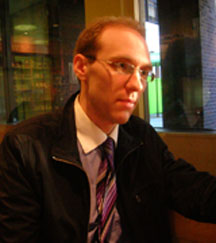 Here’s some great news for the Sequenza21 community. The super-hot Philadelphia-based chamber ensemble Relâche is presenting a concert of new works, including the premiere of our own Galen H. Brown’s Waiting in the Tall Grass, at the Greenwich House Music School in downtown Manhattan on November 30, followed by a repeat performance the following night at the International House in Philadelphia. The concert will also include new pieces by Duncan Neilson, Brooke Joyce and, Paul Epstein.
Here’s some great news for the Sequenza21 community. The super-hot Philadelphia-based chamber ensemble Relâche is presenting a concert of new works, including the premiere of our own Galen H. Brown’s Waiting in the Tall Grass, at the Greenwich House Music School in downtown Manhattan on November 30, followed by a repeat performance the following night at the International House in Philadelphia. The concert will also include new pieces by Duncan Neilson, Brooke Joyce and, Paul Epstein.
Says here in the press release (Galen is much too modest to make a call or send me a heads-up e-mail himself) that
…Brown’s music has been described as “bright, passionate music for a brighter, more passionate new day” by Kyle Gann, former critic for the Village Voice. With roots in both Minimalism and electronic rock, he writes rhythmically driven music where melodic riffs and fragments shift against each other, evolving an intricate counterpoint beneath a surface which is sometimes propulsive, sometimes placid.
Describing his new piece, Brown says “While this piece isn’t at all programmatic, the title Waiting in the Tall Grass is intended to evoke the sense of a sort of purposeful stasis, with perhaps a hint of foreboding. The ‘tall grass’ is, of course, where the predator lies in wait for its prey.”
Brown lives in New York City. He holds a Masters degree from New England Conservatory, where he studied with Lee Hyla; his other primary teachers were David Rakowski and Jon Appleton. A contributing editor at Sequenza21.com, he regularly reviews concerts and CDs, and writes on issues ranging from compositional techniques and history to aesthetic philosophy to the structure of the music industry. Sequenza21 won an ASCAP Deems Taylor award in 2005.
Founded in 1977, Relâche has been a significant force in new classical music for 30 years, from co-presenting the landmark New Music America festival in 1987 to annual performances of Phil Kine’s classic Unsilent Night. The new works on this concert are the latest in a rich history of commissions from composers such as John Cage, Philip Glass, Michael Nyman, and Pauline Oliveros.
Well done, Galen. As we say down in Appalachia where I grew up: “We’re right proud of you.”
There’s a sample of the piece here. The rather strange picture was taken by me in the Sequenza21 office at Starbucks on 57th between Eighth and Ninth.